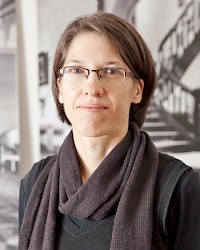Vita
Heike Delitz, born 1974, studied first architecture and then sociology and philosophy at Technical University Dresden. From 2005 to 2008, Delitz was a research associate at the Internationales Graduiertenkolleg 625 “Institutionelle Ordnungen, Schrift und Symbole/Ordres institutionnels, écrit et symboles” at TU Dresden and E.P.H.E. Paris. In 2009 she received her Ph.D., linked to the chair of Sociological Theory, History of Sociological Thought and Cultural Sociology (Karl-Siegbert Rehberg), with the dissertation “Architektur als Medium des Sozialen”.
From 2008 to 2012, Delitz was first academic staff, and than research associate at University Bamberg, chair of Sociology II (Sociological Theory) and chair of Philosophy II (Practical Philosophy) with fellowships of the Universität Bamberg and of the “Bayerische Eliteförderung”. In this time she worked on her research project on the „Effects of Henri Bergson in French Sociological Thought. Aversions, Attractions and a Paradigm of Sociological Thought“. 2013 she reseived her venia legendi for “Sociology”. Since 2013 she is Privatdozentin at University Bamberg, chair of Sociology II (Sociological Theory). In 2014 she was temporary Professor for Sociological Theory at the Max-Weber-Institute of Sociology, University Heidelberg.
Dated from 2015
IKKM Research Project
Societies of cities, societies of tents
Architectures are weaving on the 'social stuff'. By no means these artifacts, this techniques of culture are mere 'reflections', only secondary 'expressions' or 'mirrors' of an somehow already given society. Architectural artifacts in general could be defined in contrary as framing the social (B. Cache), or maybe more precisely, as (active, productive) ‘medium’ of the social. Hereby the materials have their own nomos, their becoming, causing differences within the visual, tactile, and affective shape of the 'imaginary instituted society' (C. Castoriadis), as well as in the individual perceptions and affections. So, architectonic artifacts actively take part on society’s constitution or institution: With a specific architectural shape, and with specific assemblages of these artifacts and the (human and nonhuman) bodies, a society institutes these very social divisions (in generations, gender, functions, strata, etc.), these relations to natural environment; these political, religious, economical idiosyncrasies, these social imaginations, or these institution of the 'social corpus'. Of course, the named artifacts hereby never stand alone; they are being effective always together with manifold discourses, pictures, sounds and so on – other media or socio-cultural techniques. But architectures have their own symbolic and affective logic, their own momentum; as these artifacts always stands in relation to our bodies, as they are the permanent 'agencements' of our live, and as they are percept not only visual, but also tactile and kinetic.
The project, placed between sociology, architecture, ethnology, archeology and historical sciences, share therewith central axioms of the IKKM; it shares also and namely the 'new social ontology', i.e. the openness of the question, who or what is to understood as socius. In some societies, architectures or architectural details actually are socii, to whom one has to care for social relations.
The social activity of the architectonic is true in many respects, and it is true in remarkable differences. Therefore, the research project aims to create an anthropological tableau, a matrix of the different possible ways, in which collectives constitute or institute themselves - as a very specific society – architectonic, through architecture (including furniture and infrastructure). The matrix takes part from the architectonic relation of the societies to the ground, to earth. This is the most basic architectonic decision, and it is at the same time a decision concerning the material. With both decisions, various aspects of the architectonic artifacts follow, and with them various social effects: It makes a societal difference in many respects, whether a collective fixes itself in ground - through built, hard infrastructures and buildings (materials like stone, concrete, metal, clay, etc.) (fixed societies), or if a collective is moving as whole thanks to its light, mobile, woven or stitched architectures of skin, felt or wool permanently (mobile societies, societies of tents). It further makes a difference, whether fixed collectives are concentrating on certain points (societies of cities, infrastructure societies), implying far reaching infrastructures, or in the contrary dissipates themselves (residential atomism, societies on ‚point zero of social integration‘, Ph. Descola for the Achuar). And it makes a societal difference, if they have structural architecture ('Hochbau'), or in contrary 'a-structural architecture' ('Tiefbau'). This is the case of digged-in societies, namely the Yao Dong within the Chinese Loess, which is in many regards the contrary to ‘us’.
So, there are - ideal-typical - four very different ways, how collectives institute themselves through the medium of their architectonic and infrastructural activities, how they gives themselves a very specific visibility, arranging their individuals in visual and bodily perceived manner: (1) societies of cities, fixed, infrastructured societies; (2) societies of tents, mobile societies; (3) residential atomism, fixed, but dispersed societies; (4) digged-in-societies, fixed, but non-urban societies.
This - a-historic, non-evolutionary, synchronic - matrix of four very different architectural-based relations from the collective to the ground allows as well to reach hybrid socio-architectonic constellations (for instance semi-nomadic collectives) as manifold historical transformations; and to understand them in their societal effects. At the IKKM, I will be concentrated on the comparison between fixed, infrastructured, urban societies on the one hand - those, which fixe themselves within earth, in this way creating through their 'heavy' and 'hard' architectural activities a 'striated space' (Deleuze) - with mobile, nomadic societies on the other hand. These societies permanently move themselves, as a whole collective, through and thanks to their stitched (woven, wattled ...) architectures and its 'weak', soft materials, creating a 'smooth space' and specific affections. Indeed, in many concerns, especially 'stitched' and 'built' architectures differentiate, and with them two types of societies and their subjects.
